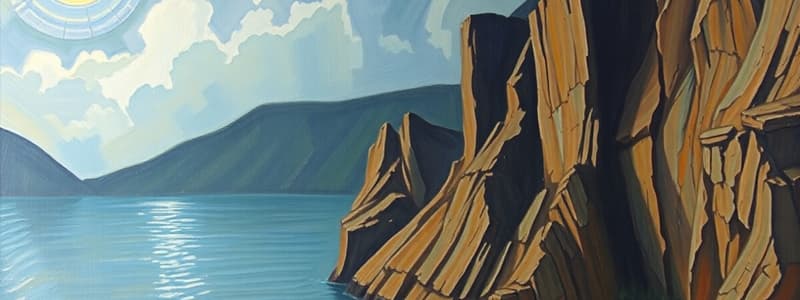Podcast
Questions and Answers
The sudden movements of the Earth can cause a ______
The sudden movements of the Earth can cause a ______
earthquake
The ______ is a depositional feature of a glacier.
The ______ is a depositional feature of a glacier.
moraine
A ______ is a landform created by a river that resembles a horseshoe or a U-shaped curve.
A ______ is a landform created by a river that resembles a horseshoe or a U-shaped curve.
oxbow lake
The movement of the Earth's tectonic plates is caused by ______ forces.
The movement of the Earth's tectonic plates is caused by ______ forces.
Water, wind, and ice are all examples of ______ forces.
Water, wind, and ice are all examples of ______ forces.
The process of ______ is the wearing away and transportation of rock and soil by natural forces.
The process of ______ is the wearing away and transportation of rock and soil by natural forces.
A ______ is a flat, fertile area along a river that is formed by the deposition of sediments.
A ______ is a flat, fertile area along a river that is formed by the deposition of sediments.
The ______ of a beach is constantly changing due to the action of waves.
The ______ of a beach is constantly changing due to the action of waves.
The erosion of rock by waves over time can create ______ along the coast.
The erosion of rock by waves over time can create ______ along the coast.
The shape of a ______ is formed by the wind blowing sand across a desert landscape.
The shape of a ______ is formed by the wind blowing sand across a desert landscape.
Flashcards
Erosion
Erosion
The process of breaking down and transporting rocks, soil, and other materials by natural forces like wind, water, and ice.
Folding
Folding
The gradual bending and folding of rock layers due to pressure from within the Earth.
Flood plain
Flood plain
A flat, fertile area along a river formed by deposits of sediment during floods.
Sand dunes
Sand dunes
Signup and view all the flashcards
Oxbow lake
Oxbow lake
Signup and view all the flashcards
Plate tectonics
Plate tectonics
Signup and view all the flashcards
Endogenic forces
Endogenic forces
Signup and view all the flashcards
Exogenic forces
Exogenic forces
Signup and view all the flashcards
Earthquake
Earthquake
Signup and view all the flashcards
Erosional features of sea waves
Erosional features of sea waves
Signup and view all the flashcards
Study Notes
Lithosphere and Plate Movement
- The lithosphere is divided into several plates (lithospheric plates)
- These plates move slowly, a few millimeters per year, due to molten magma movement within the Earth
- The movement of these plates causes changes on Earth's surface
- Endogenic forces originate inside the Earth, causing sudden and slow movements
- Exogenic forces act on Earth's surface, altering landforms
Endogenic Forces
- Include earthquakes and volcanoes
- Earthquakes are vibrations caused by movement within the Earth's crust (focus)
- The epicenter is the point on the surface directly above the focus
- Earthquakes are measured on the Richter scale
- Volcanoes are vents through which molten material erupts
Exogenic Forces
- Include weathering, erosion, and deposition caused by water, wind, and ice
- Water erodes landforms (e.g. waterfalls, meanders, floodplains)
- Ice erodes landforms (e.g. glacial moraines, lakes)
- Wind erodes and deposits materials (e.g. sand dunes, loess)
- Sea waves cause erosion and deposit sediments (e.g. sea caves, stacks, arches, beaches)
Landforms
- Landforms are the shapes of Earth's surface created by various forces (endogenic, exogenic)
- Earthquakes and volcanoes create sudden and dramatic changes
- Rivers, glaciers, seas, and wind create gradual changes over time
- Examples include sand dunes, floodplains, valleys, mountains, and waterfalls
Activities & Observations
- Observations of coloured paper pellets in water demonstrating heat transfer and currents can indicate convection
- Experiments using water, containers, and objects can be used to simulate earthquakes and other processes and illustrate physical concepts
Studying That Suits You
Use AI to generate personalized quizzes and flashcards to suit your learning preferences.




